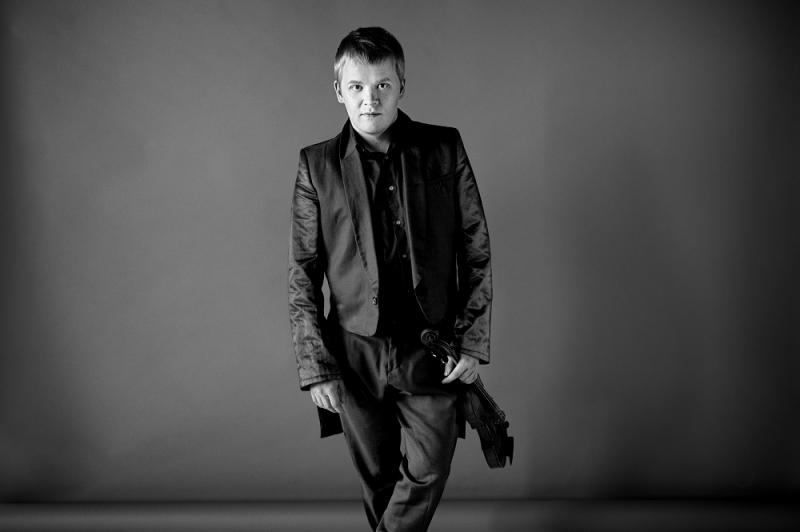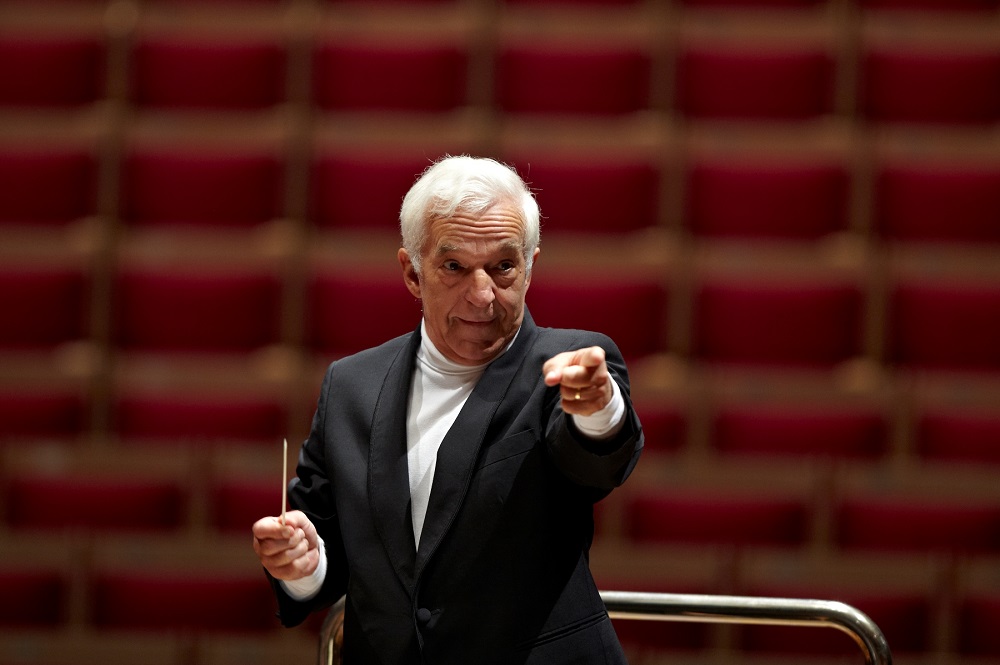Kuusisto, London Chamber Orchestra, Ashkenazy, Cadogan Hall | reviews, news & interviews
Kuusisto, London Chamber Orchestra, Ashkenazy, Cadogan Hall
Kuusisto, London Chamber Orchestra, Ashkenazy, Cadogan Hall
Elegies abounding in Elgar and Sibelius, but the encore was the biggest tearjerker

Tears were likely to flow freely on this most beautiful and terrible of June evenings, especially given a programme – dedicated by Vladimir Ashkenazy to the victims of the Grenfell Tower fire – already prone to the elegiac.
He told us he'd planned to play a "jolly Finnish folksong", but that wouldn't be right under the circumstances; so he gave us instead his own apparently improvised reflections on a Finnish children's song, "The Guardian Angel". Where did it come from? Out of an ether created by a tissue of sounds and harmonics, I know not how exactly, brought into unison focus with the sweetest whistling. Such magic can only be experienced, not described.
Kuusisto's Sibelius Violin Concerto was unlike any other I've heard. Expecting the usual tricky negotiation of a treacherous canyon and a glacier, we got a walk in the park. It seemed as effortless as that for Kuusisto – well, everything bar the fiendish passage in the finale, heard twice, which in my experience only Viktoria Mullova has managed flawlessly – and though there was an avoidance of late romantic intensity, two withdrawals into near-silence in the outer movements wrought their own enchantment. What fun, too, to see some distinguished orchestral violinists – Gina McCormack among them – visibly relishing Kuusisto's idiosyncrasies.

The London Chamber Orchestra strings distinguished themselves at the start in Elgar's Introduction and Allegro, the right balance of sadness, nostalgia and – once the initially featherlight central fugue got under way – intense anger. To hear all the violins suddenly taking up what Elgar called his "Welsh tune" halfway through was a real heart-in-mouth moment. Cadogan Hall acoustics suit a full string orchestra well, the resonance of double basses going right through you.
Heartbreak at the other end of the dynamic scale came in Sibelius's strange meditation The Bard – a difficult work to programme, short and until the brief unleashing of trombones never showy, but so poetic and with perhaps the most enigmatic harp solo in the repertoire, exquisitely taken by Deian Rowlands. Full credit to Ashkenazy (pictured above by Keith Saunders) for knowing where to place it in a programme of works which, fascinatingly, all begin in a minor key and end, however tentatively, in the major.
Sibelius and Elgar were musical citizens of the world, but both knew how to tap in to their native wood notes at the deepest level. That's true even among the portraits of Worcestershire society folk and others in the universal genius of the Enigma Variations. It's a demanding work for all facets of a conductor's technique; Ashkenazy caught the humour but not the levitational moments – and a cue for will-o-the-wisp Dorabella went completely over the string players' heads as they turned the page. Understandably premature on Ashkenazy's part: he wanted continuity and missed it here, but picked up a few seconds later as if nothing had happened (which as far as the musicians were concerned seemed to be the case).
A few moments of untogetherness suggested a rehearsal or two more of this tricky music might not have gone amiss, and Ashkenazy's attempt at rubato felt a bit unnatural at times, not least in the theme itself, but his heart was, as always, in the right place. Above all he made sure that the singing line guided "Nimrod", avoiding any hint of the placid parochial in what is after all a portrait of a German (AJ Jaeger of Elgar's publisher Novello), inspired by a German's slow movement (in Beethoven's "Pathétique" Sonata). Not, perhaps, a performance to merit the unmodified rapture of a rather too much all-of-a-kind audience, with a penchant for protracted, uncovered coughs in the wrong places, but a generous conclusion to a well-planned programme that took on even greater resonance than originally intended.
rating
Share this article
The future of Arts Journalism
You can stop theartsdesk.com closing!
We urgently need financing to survive. Our fundraising drive has thus far raised £49,000 but we need to reach £100,000 or we will be forced to close. Please contribute here: https://gofund.me/c3f6033d
And if you can forward this information to anyone who might assist, we’d be grateful.

Subscribe to theartsdesk.com
Thank you for continuing to read our work on theartsdesk.com. For unlimited access to every article in its entirety, including our archive of more than 15,000 pieces, we're asking for £5 per month or £40 per year. We feel it's a very good deal, and hope you do too.
To take a subscription now simply click here.
And if you're looking for that extra gift for a friend or family member, why not treat them to a theartsdesk.com gift subscription?
more Classical music
 Bizet in 150th anniversary year: rich and rare French offerings from Palazzetto Bru Zane
Specialists in French romantic music unveil a treasure trove both live and on disc
Bizet in 150th anniversary year: rich and rare French offerings from Palazzetto Bru Zane
Specialists in French romantic music unveil a treasure trove both live and on disc
 Scottish Chamber Orchestra, Ibragimova, Queen’s Hall, Edinburgh review - rarities, novelties and drumrolls
A pity the SCO didn't pick a better showcase for a shining guest artist
Scottish Chamber Orchestra, Ibragimova, Queen’s Hall, Edinburgh review - rarities, novelties and drumrolls
A pity the SCO didn't pick a better showcase for a shining guest artist
 Kilsby, Parkes, Sinfonia of London, Wilson, Barbican review - string things zing and sing in expert hands
British masterpieces for strings plus other-worldly tenor and horn - and a muscular rarity
Kilsby, Parkes, Sinfonia of London, Wilson, Barbican review - string things zing and sing in expert hands
British masterpieces for strings plus other-worldly tenor and horn - and a muscular rarity
 From Historical to Hip-Hop, Classically Black Music Festival, Kings Place review - a cluster of impressive stars for the future
From quasi-Mozartian elegance to the gritty humour of a kitchen inspection
From Historical to Hip-Hop, Classically Black Music Festival, Kings Place review - a cluster of impressive stars for the future
From quasi-Mozartian elegance to the gritty humour of a kitchen inspection
 Shibe, LSO, Adès, Barbican review - gaudy and glorious new music alongside serene Sibelius
Adès’s passion makes persuasive case for the music he loves, both new and old
Shibe, LSO, Adès, Barbican review - gaudy and glorious new music alongside serene Sibelius
Adès’s passion makes persuasive case for the music he loves, both new and old
 Anja Mittermüller, Richard Fu, Wigmore Hall review - a glorious hall debut
The Austrian mezzo shines - at the age of 22
Anja Mittermüller, Richard Fu, Wigmore Hall review - a glorious hall debut
The Austrian mezzo shines - at the age of 22
 First Person: clarinettist Oliver Pashley on the new horizons of The Hermes Experiment's latest album
Compositions by members of this unusual quartet feature for the first time
First Person: clarinettist Oliver Pashley on the new horizons of The Hermes Experiment's latest album
Compositions by members of this unusual quartet feature for the first time
 Gesualdo Passione, Les Arts Florissants, Amala Dior Company, Barbican review - inspired collaboration excavates the music's humanity
At times it was like watching an anarchic religious procession
Gesualdo Passione, Les Arts Florissants, Amala Dior Company, Barbican review - inspired collaboration excavates the music's humanity
At times it was like watching an anarchic religious procession
 Classical CDs: Camels, concrete and cabaret
An influential American composer's 90th birthday box, plus British piano concertos and a father-and-son duo
Classical CDs: Camels, concrete and cabaret
An influential American composer's 90th birthday box, plus British piano concertos and a father-and-son duo
 Cockerham, Manchester Camerata, Sheen, Martin Harris Centre, Manchester review - re-enacting the dawn of modernism
Two UK premieres added to three miniatures from a seminal event of January 1914
Cockerham, Manchester Camerata, Sheen, Martin Harris Centre, Manchester review - re-enacting the dawn of modernism
Two UK premieres added to three miniatures from a seminal event of January 1914
 Kempf, Brno Philharmonic, Davies, Bridgewater Hall, Manchester review - European tradition meets American jazz
Bouncing Czechs enjoy their Gershwin and Brubeck alongside Janáček and Dvořák
Kempf, Brno Philharmonic, Davies, Bridgewater Hall, Manchester review - European tradition meets American jazz
Bouncing Czechs enjoy their Gershwin and Brubeck alongside Janáček and Dvořák
 Solomon, OAE, Butt, QEH review - daft Biblical whitewashing with great choruses
Even a top soprano and mezzo can’t make this Handel paean wholly convincing
Solomon, OAE, Butt, QEH review - daft Biblical whitewashing with great choruses
Even a top soprano and mezzo can’t make this Handel paean wholly convincing

Add comment